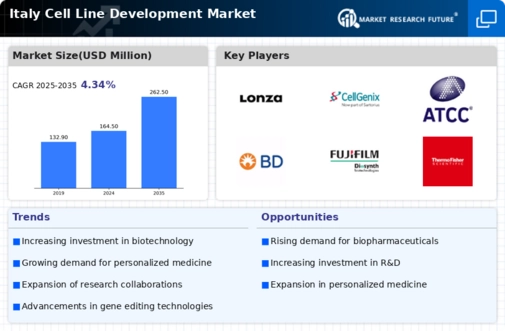Expansion of Research Institutions
Italy is home to a robust network of research institutions and universities that are actively engaged in life sciences research. The proliferation of these institutions is a key driver for the cell line-development market, as they require high-quality cell lines for various research applications. In 2025, it is estimated that over 200 research institutions in Italy are involved in cell line research, contributing to a significant portion of the market's growth. These institutions often collaborate with biotechnology companies, fostering innovation and the development of new cell lines. The synergy between academia and industry is likely to enhance the capabilities of the cell line-development market, ensuring a steady supply of advanced cell lines for research and therapeutic purposes.
Rising Demand for In-Vitro Testing
The increasing emphasis on in-vitro testing methods is reshaping the cell line-development market in Italy. As regulatory bodies advocate for alternatives to animal testing, the demand for reliable in-vitro models is on the rise. This shift is prompting researchers and pharmaceutical companies to invest in the development of human-derived cell lines that can accurately predict drug responses. In 2025, the market for in-vitro testing is projected to grow by approximately 20%, further driving the need for specialized cell lines. This trend not only aligns with ethical considerations but also enhances the efficiency of drug development processes, thereby positively impacting the cell line-development market.
Growing Focus on Personalized Medicine
The shift towards personalized medicine is significantly influencing the cell line-development market in Italy. As healthcare providers and researchers aim to tailor treatments to individual patient profiles, the demand for specific cell lines that can mimic human diseases is rising. This trend is reflected in the increasing number of clinical trials focusing on personalized therapies, which have seen a growth rate of approximately 15% annually. Consequently, the cell line-development market is adapting to meet these needs by developing more specialized cell lines. This focus on personalized medicine not only enhances treatment efficacy but also drives the demand for innovative cell line solutions, thereby propelling market growth in Italy.
Increasing Investment in Biotechnology
The cell line-development market in Italy is experiencing a surge in investment from both public and private sectors. This influx of capital is primarily directed towards research and development initiatives aimed at enhancing biopharmaceutical production. In 2025, the Italian government allocated approximately €500 million to support biotechnology projects, which is expected to bolster the cell line-development market. Furthermore, venture capital firms are increasingly recognizing the potential of biotechnology startups, leading to a rise in funding opportunities. This financial support is likely to accelerate innovation in cell line technologies, thereby expanding the market. As a result, the cell line-development market is poised for growth, driven by the increasing financial commitment to biotechnology in Italy.
Technological Advancements in Cell Culture
Technological innovations in cell culture techniques are playing a pivotal role in the evolution of the cell line-development market in Italy. Recent advancements, such as 3D cell culture and automated cell line generation, are enhancing the efficiency and scalability of cell line production. These technologies enable researchers to create more physiologically relevant models, which are crucial for drug discovery and development. In 2025, it is anticipated that the adoption of these advanced technologies will increase by around 25%, significantly impacting the market. As a result, the cell line-development market is likely to benefit from improved productivity and reduced costs, fostering a more competitive landscape in Italy.























Leave a Comment